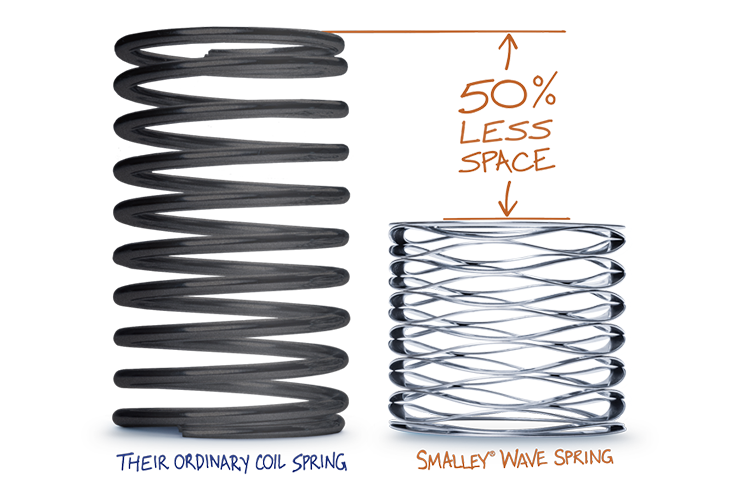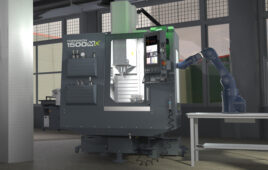
Custom or standard, Smalley takes great pride in its unparalleled dedication to delivering quality wave spring solutions for a variety of industries. Both wave springs and traditional coil springs fall under the category of compression springs. While the primary function of a compression spring is to provide axial load, wave springs have a few key differences and advantages when compared to coil springs.
Wave Springs Save Space
The key advantage of using a wave spring is in the axial space savings. Whether it is a static or dynamic application, wave springs may be the ideal solution where space is a constraint.
The apparent difference between a wave spring and a coil spring is the height. A wave spring can provide the same force and deflection as a coil spring but in considerably less axial space. Wave springs have up to a 50% reduced height, mainly because of the following two design features:
(1) Flat Wire
Coil springs are typically made of round wire, while wave springs use flat wire. Flat wire takes up less vertical space than round wire, which contributes to the reduction in work height.
(2) Waves
Just as the name implies, a wave spring has multiple waves per turn. The wave design contributes to the load output of the spring. In the image below, we have a flat wire coil spring, a traditional coil spring, and a wave spring, respectively.
Because a flat wire coil spring has a thinner cross-section in comparison to the coil spring, a taller free height is required to achieve a similar load output. On the other hand, a wave spring also has a thin cross-section, yet has the lowest free height. This is due to the unique Crest-to-Crest design, which allows for similar spring rates to a coil spring, but with axial space-saving capabilities.
Now that you understand the most notable difference between a coil spring and a wave spring, let’s go over some commonly asked questions.
- Can a wave spring replace a coil spring?
Wave springs can provide similar forces as a traditional coil spring at down to about half the height of a coil spring. Due to space and weight savings, a wave spring cannot be directly substituted for a coil spring in your existing application without reducing the size of the spring cavity. Wave springs must be designed into your application in order to realize all of the benefits. - Does a wave spring provide the same function as a coil spring?
Yes, a wave spring provides the same function as a coil spring. Both wave springs and coil springs apply force axially when compressed. A wave spring starts out at free height, which is the height without any load applied. The wave spring is then compressed until its work height, where a specified load is output. This is the same as a coil spring follows.The difference between a wave spring and a coil spring lies in the way they store and release energy. Wave springs rely on bending, similar to a simple beam, whereas coil springs are torsional. As a load is applied, the waves on the wave spring begin to flatten to provide an upward force, allowing for complete axial load transmission. Coil springs, on the other hand, twist as they compress, so not all the force is necessarily aligned with the axis.
- Can a wave spring be made with the same or higher spring rate, compared to a helical coil spring?
In most cases, the spring rate can be matched or increased with various modifications such as the number of waves, material thickness, or number of turns. Please note that we tolerance load at a working height, unlike a coil spring that tolerances the spring rate. - Are wave springs cheaper than coil springs?
Wave springs can save you money when considering the whole assembly. Crest-to-Crest wave springs allow for smaller assemblies with a reduced spring height, which results in a smaller spring cavity. This translates into considerable cost-savings for the surrounding assembly, resulting in a net saving that far outweighs the cost variance between the wave spring and coil spring.Bottom line? Wave springs may potentially have a higher piece price, but overall cost savings may be seen when designing a wave spring into your application.
- So you’re telling me a wave spring can make my assemblies smaller and potentially save me money, why wouldn’t I use this for everything?
Wave springs are the ideal compression spring to fit tight axial and radial spaces; however, they are not the ideal solution for applications with large travel and/or accompanied by a high load requirement. Let’s take a pogo stick for example. A spring in a pogo stick must have a large travel and the load output to rebound the weight of a human, making it better suited for a traditional coil spring.Other applications where an alternative spring should be used is in cases where extension or torsion is required. Wave springs are designed for compression only.
- I’m using a coil compression spring in my assembly and am ready to switch to a wave spring design to help with space savings. What do I need to know to find the wave spring best suited for my application?
Since a wave spring is typically not a direct replacement for a coil spring, a good place to start is to provide us with the parameters in which the wave spring will be working. Please fill out our Spring Application Checklist and a Smalley Engineer will contact you shortly to discuss your application.
Key Points
- Both wave springs and coil springs are used to transmit axial load, butdiffer in the applications for which they are best suited for.
- Wave springs are the ideal solution for tight radial and axial spaces.
- Wave springs providing the same force and deflection as a coil spring in up to 50% less space.
- Significant cost savings may be seen with a smaller, more light-weight assembly, as it takes less time and material to produce.
Interested in learning more about wave springs?
Check out our new E-Book below.
Sponsored content by Smalley
Filed Under: SPONSORED CONTENT






